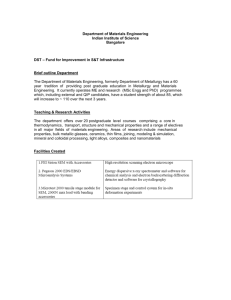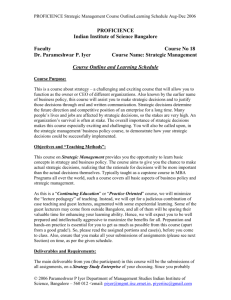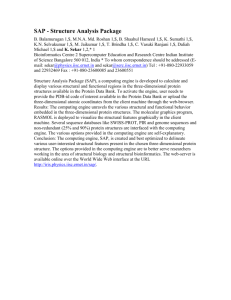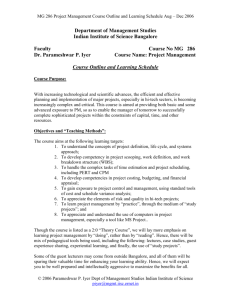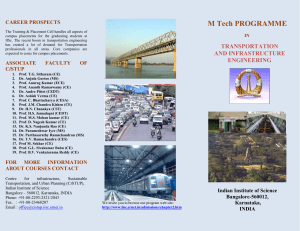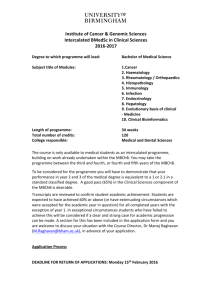Supply Chain Dynamics - Game Theory Lab, CSA, IISc
advertisement
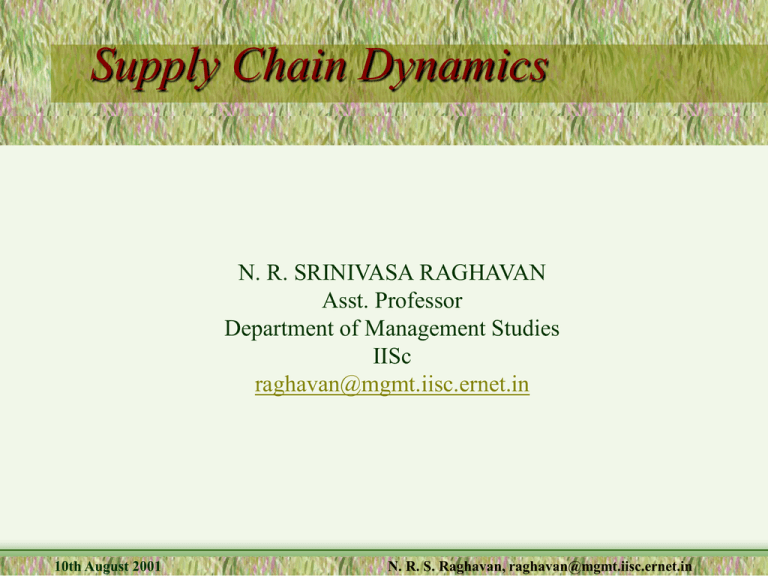
Supply Chain Dynamics N. R. SRINIVASA RAGHAVAN Asst. Professor Department of Management Studies IISc raghavan@mgmt.iisc.ernet.in 10th August 2001 N. R. S. Raghavan, raghavan@mgmt.iisc.ernet.in Introduction Oliver and Webber coined SCM in 1982 Their Thesis: Top Management alone can ensure nonconflicting functional objectives along SCN An integrated systems strategy be developed and implemented Coordination of M-I-F flows is challenging yet rewarding 10th August 2001 N. R. S. Raghavan, raghavan@mgmt.iisc.ernet.in Research in SCM Research in Integration and Coordination started much before 1982: Channel Research (Alderson 1957) Collaboration and Cooperation (Bowersox 1969) Location and Control of Inventories in SCN's (Hanssmann 1959) Hierarchical Production Planning (Hax and Meal 1975) Bullwhip effect in SCN's (Forrestor 1958) 10th August 2001 N. R. S. Raghavan, raghavan@mgmt.iisc.ernet.in 1. Channel Research Alderson: Market Behavior and Executive Action (book) 1957: Principles of Postponement Product postponement occurs in two ways: Manufacturing PP: Changes in form and identity occur @ the latest possible point in the SCN Logistics PP: Changes in inventory location occur @ the latest possible point in time HP Deskjet Printers: Lee et al., Interfaces, 1995. Power cords, Voltage requirements, fonts, etc. 10th August 2001 N. R. S. Raghavan, raghavan@mgmt.iisc.ernet.in Channel Research (contd) Advantages of PP: Hedge against uncertain customer demand Reduce inventory holding cost Reduce Logistics/Warehousing costs Minimize imbalance in stock distribution Eliminate stages in Manufacturing Eg: packaging, customer does assembly etc. 10th August 2001 N. R. S. Raghavan, raghavan@mgmt.iisc.ernet.in Features of PP Loss of Economies of Scale! Requires quick set ups and agile procurement Reduced risk of product obsolescence Requires increased capability to process, transmit, and deliver orders Product should be "DFPP" (Should be technically and economically feasible) 10th August 2001 N. R. S. Raghavan, raghavan@mgmt.iisc.ernet.in Channel Research: CODP The location of decoupling point depends on the product BOM: A, V, X, T Relevant more for X and T Trade-off between: Inventory holding costs: increase @ ~20% from L2R Estimated based on expected inventories at echelons given by the inventory control policies Cost of Lost Sales: increase @ ~20% from R2L Estimated based on given demand distribution and probability of stock outs 10th August 2001 N. R. S. Raghavan, raghavan@mgmt.iisc.ernet.in 2. Research on Collaboration and Coordination Bowersox: Physical Distribution Development, J of Marketing, Vol 33, 1969 Individual objectives of different functional units within a firm may counteract overall efficiency Manufacturing: Long production runs Procurement: Lowest procurement costs Marketing: FGI Staging and infinite assortments Finance: Low inventories Logistics: FTL's 10th August 2001 N. R. S. Raghavan, raghavan@mgmt.iisc.ernet.in Research on Collaboration and Coordination (contd) Tom Malone (MIT, CCS): Computers, Networks, and the Corporation, Scientific American, 265:3, 1991 Compares performance of various organization structures wrt organizational goals and KPI's Information Sharing (Transparency) using ICT SCM/ERP Solutions B2B Markeplaces B2C and CRM 10th August 2001 N. R. S. Raghavan, raghavan@mgmt.iisc.ernet.in 3. Location and Control of Inventories Hanssmann: Optimal inventory location and control in pdn/distbn networks, Mangement Science, 7:4, 1959 Analytical model (DP) of interacting inventories with three serial inventory locations: Each location follows periodic rev, order up to policy Lead time is a positive multiple of review period Customer demand is Normal Trades off shortage costs with inventory holding costs; considers revenues as a function of delivery time 10th August 2001 N. R. S. Raghavan, raghavan@mgmt.iisc.ernet.in Location and Control of Inventories (Contd) Supply Rationing Problem: Given shortage in supplies, how to allocate stock across echelons Threshold policies for high priority customers (Ha 1997) Minimize total imbalance in stock distribution s.t. service level constraints (Van der Heijden 1997) Hundreds of articles in various journals including OR, MS, EJOR, JORS, IJPR, IJPDLM, JOM, etc. Logistics given scant treatment in IC problems: assumed deterministic Results in failure of such models in practice 10th August 2001 N. R. S. Raghavan, raghavan@mgmt.iisc.ernet.in 4. Hierarchical Production/Distribution Planning Hax and Meal: Hierarchical integration of production planning and scheduling, Studies in Management Sc., Vol 1, 1975. Provide effective decision support for different DM levels within a hierarchical organization Based on the following scheme: Decompose to get hierarchical structure (Stgc-Tac-Opn) Do Aggregation where possible (eg. Forecasts: agg. on time,products,markets; Capacity: agg. On resources) Hierarchical coordination (by setting targets+getting f/b) 10th August 2001 N. R. S. Raghavan, raghavan@mgmt.iisc.ernet.in Hierarchical Planning (Contd) Other elements: Model building for each decision unit using a mathematical model (ILP/DP/QN/PN) keeping solvability in mind Model solving: Solution procedure detailed to get the plan Cohen and Lee, OR 1989: Solved an integrated inventory/production/distribution model hierarchically Software Agent based frameworks available Eg. A-Teams of IBM 10th August 2001 N. R. S. Raghavan, raghavan@mgmt.iisc.ernet.in 5. Bullwhip Effect in Supply Chains Forrestor: Industrial Dynamics, HBR, 36:4, 1958 First research paper to illustrate systems dynamics in SCN's Base for developing Distribution Games "BWE" coined by P&G BWE describes the increasing amplification of orders occuring within a SC Resembles a whip lash Occurs even if end-item demand is fairly stable! Forrestor studied a simulation model of the simplest tandem supply chain with four entities: Retailer, DC, W/H, Plant 10th August 2001 N. R. S. Raghavan, raghavan@mgmt.iisc.ernet.in Bullwhip Effect (contd) Assumptions of Forrestor's model: Each entity can make use of only locally available info Time delays between ordering and receipt of order It takes 3 weeks for retailer to process the order, half a week to transmit it to DC The DC takes 1 week to process the order and one week to ship to the retailer, who takes one week to ship to end customer; assumptions for other entities likewise.. To study impact of a one time +10% change in retail sales on orders placed and inventory levels 10th August 2001 N. R. S. Raghavan, raghavan@mgmt.iisc.ernet.in Bullwhip Effect (contd) Forrestor's results: "...A sudden 10% increase in retail sales implies a peaking of 34% on orders @ 14th week in factory w/h, resulting in factory output peaking in 21st week (including a 6 week lead time) by a whopping 45%.." Amplified and out of phase fluctuations in ordering and inventory levels Avoidable inventory and shortage costs; Unstable system RELEVANT EVEN TODAY! Replace week by day in the above analysis 10th August 2001 N. R. S. Raghavan, raghavan@mgmt.iisc.ernet.in Bullwhip Effect: Some Illustrations 10th August 2001 N. R. S. Raghavan, raghavan@mgmt.iisc.ernet.in Bullwhip Effect: Some Illustrations 10th August 2001 N. R. S. Raghavan, raghavan@mgmt.iisc.ernet.in Bullwhip Effect (contd) Causes of BWE: (Empirical: Lee et al: 1997; Analytical: Chen et al: 2000) Demand Signal Processing (frequent updates of forecasts; only next echelon orders considered) Order Batching (to realise logistics EoS+Reducing order processing costs) Price Fluctuations (resulting in over-reactions) Supply Rationing (Proportionate rationing; unrestricted order acceptance+free return policy) 10th August 2001 N. R. S. Raghavan, raghavan@mgmt.iisc.ernet.in Counter-Measures for BWE Avoid multiple demand forecasts Order based on ultimate customer demand Use EDI+POS+VMI Choose a good forecasting method (PLC has a major say) Move from decentralized DM to centralized planning (visibility+control is better) Remove layers in channel if possible Eg: HP, Apple, IBM, P&G/Walmart 10th August 2001 N. R. S. Raghavan, raghavan@mgmt.iisc.ernet.in Counter-Measures for BWE (contd) Break order batches Increase frequency of ordering (OP costs reduced by EDI) Resort to standardization to minmize OP costs Use 3PL to make small batch replenishments economical Aggregate across retail outlets to utilize FTL EoS Reduce safety stocks by cutting lead times Eg: 3PL using Fedex, P&G 10th August 2001 N. R. S. Raghavan, raghavan@mgmt.iisc.ernet.in Counter-Measures for BWE (contd) Stabilize prices EDLP (P&G) Special purchase contracts Eliminate shortage gaming Allocate based on past sales (Sun) Share capacity and information (HP, Motorola) Limit flexibility wrt time (HP, Seagate) 10th August 2001 N. R. S. Raghavan, raghavan@mgmt.iisc.ernet.in The Distribution Game Sterman: Modeling managerial behaviorMisperceptions of f/b in a dynamic DM expt, Management Science, 35:3, 1989 "Beer Distribution Game" Bounded rationality depicts decision makers Orders based on current inventory status, amount ordered by direct successors, past performance Over-reaction; increases steadily towards u/s end of SCN 10th August 2001 N. R. S. Raghavan, raghavan@mgmt.iisc.ernet.in
